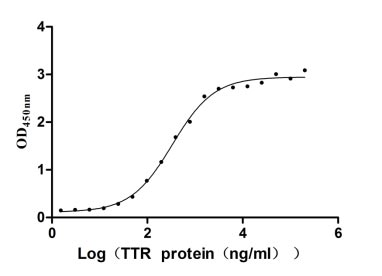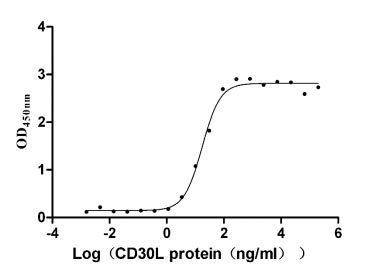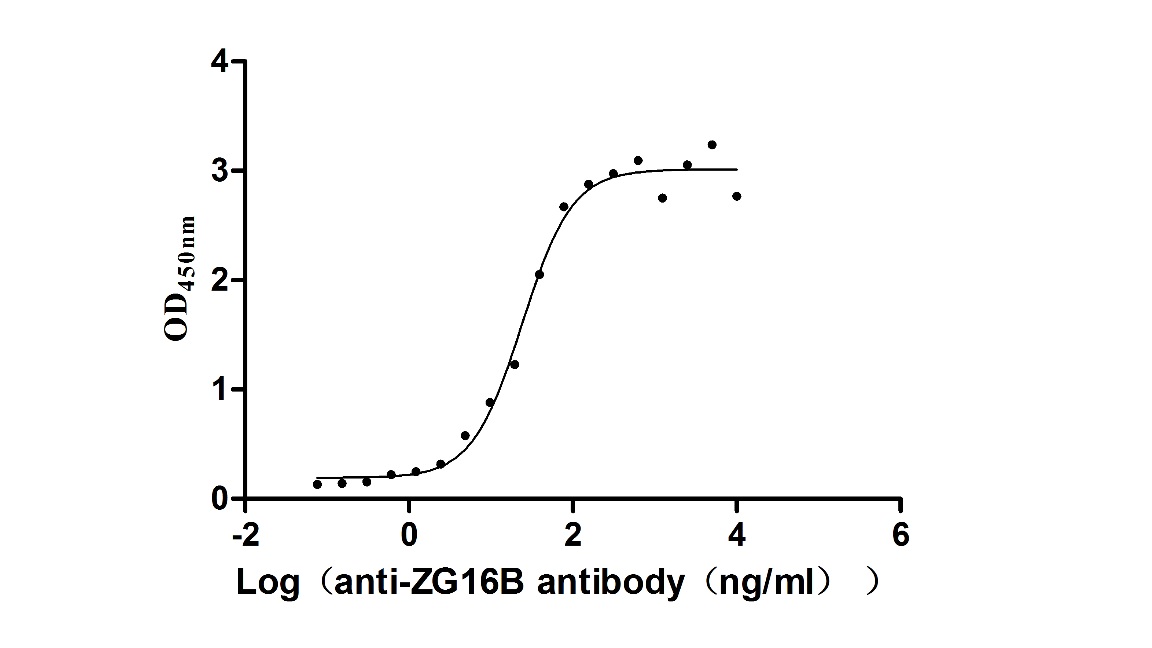Recombinant Rat Fractalkine (Cx3cl1)
-
货号:CSB-CF006235RA
-
规格:
-
来源:in vitro E.coli expression system
-
其他:
产品详情
-
基因名:
-
Uniprot No.:
-
别名:Cx3cl1; Acc1; Fkn; Scyd1; Fractalkine; C-X3-C motif chemokine 1; CX3C membrane-anchored chemokine; Neurotactin; Small-inducible cytokine D1
-
种属:Rattus norvegicus (Rat)
-
蛋白长度:Full Length of Mature Protein
-
表达区域:25-393
-
氨基酸序列QHLGMTKCNITCHKMTSPIPVTLLIHYQLNQESCGKRAIILETRQHRHFCADPKEKWVQDAMKHLDHQTAALTRNGGKFEKRVDNVTPRITSATRGLSPTALAKPESATVEDLTLEPTAISQEARRPMGTSQEPPAAVTGSSPSTSKAQDAGLAAKPQSTGISEVAAVSTTIWPSSAVYQSGSSLWAEEKATESPPTIALSTQASTTSSPKQNVGSEGQPPWVQEQDSTPEKSPGPEETNPVHTDIFQDRGPGSTVHPSVAPTSSEKTPSPELVASGSQAPKVEEPIHATADPQKLSVFITPVPDSQAATRRQAVGLLAFLGLLFCLGVAMFAYQSLQGCPRKMAGEMVEGLRYVPRSCGSNSYVLVPV
Note: The complete sequence including tag sequence, target protein sequence and linker sequence could be provided upon request. -
蛋白标签:N-terminal 10xHis-tagged
-
产品提供形式:Liquid or Lyophilized powder
Note: We will preferentially ship the format that we have in stock, however, if you have any special requirement for the format, please remark your requirement when placing the order, we will prepare according to your demand. -
缓冲液:Lyophilized from Tris/PBS-based buffer, 6% Trehalose, pH 8.0
-
储存条件:Store at -20°C/-80°C upon receipt, aliquoting is necessary for mutiple use. Avoid repeated freeze-thaw cycles.
-
保质期:The shelf life is related to many factors, storage state, buffer ingredients, storage temperature and the stability of the protein itself.
Generally, the shelf life of liquid form is 6 months at -20°C/-80°C. The shelf life of lyophilized form is 12 months at -20°C/-80°C. -
货期:Basically, we can dispatch the products out in 1-3 working days after receiving your orders. Delivery time may differ from different purchasing way or location, please kindly consult your local distributors for specific delivery time.Note: All of our proteins are default shipped with normal blue ice packs, if you request to ship with dry ice, please communicate with us in advance and extra fees will be charged.
-
注意事项:Repeated freezing and thawing is not recommended. Store working aliquots at 4°C for up to one week.
-
Datasheet & COA:Please contact us to get it.
相关产品
靶点详情
-
功能:Chemokine that acts as a ligand for both CX3CR1 and integrins ITGAV:ITGB3 and ITGA4:ITGB1. The CX3CR1-CX3CL1 signaling exerts distinct functions in different tissue compartments, such as immune response, inflammation, cell adhesion and chemotaxis. Regulates leukocyte adhesion and migration processes at the endothelium. Can activate integrins in both a CX3CR1-dependent and CX3CR1-independent manner. In the presence of CX3CR1, activates integrins by binding to the classical ligand-binding site (site 1) in integrins. In the absence of CX3CR1, binds to a second site (site 2) in integrins which is distinct from site 1 and enhances the binding of other integrin ligands to site 1.; The soluble form is chemotactic for T-cells and monocytes, but not for neutrophils.; The membrane-bound form promotes adhesion of those leukocytes to endothelial cells.
-
基因功能参考文献:
- that activation of STAT3 after /muscle incision and retraction mediates the up-regulation of CX3CL1 PMID: 29313211
- basal fractalkine signalling within the trigeminal ganglion plays an important role in mechanical sensitivity of masticatory muscle sensory afferent fibers and that inhibition of CX3CR1 signaling within the trigeminal ganglia may induce analgesia through a peripheral mechanism. PMID: 27209190
- Study demonstrates that noradrenaline (NA) induces the production of CX3CL1 in neurons and that the activation of beta2-adrenergic receptors is involved in the process. The increased mRNA levels and the accumulation of this protein in the cells indicate that NA treatment stimulates neuronal expression and synthesis of CX3CL1. PMID: 27923568
- CX3CL1(+) apo-MPs released by apoptotic cells mediate the chemotactic transmigration of alveolar macrophages. PMID: 24603149
- CX3CL1/CX3CR1 signaling is involved in LTP of C-fiber-evoked field potentials in the rodent spinal dorsal horn PMID: 25768734
- up-regulation of CX3CL1 via NF-kappaB-dependent H4 acetylation might be critical for paclitaxel-induced mechanical allodynia PMID: 25494456
- CX3CL1 activates Jak2-Stat5alpha-ERK1/2 signaling through CX3CR1, thereby triggering integrin-dependent machinery reorganization to allow chemotactic migration of bone marrow-derived mesenchymal stem cells towards an ischemic cerebral lesion. PMID: 25559502
- CX3CR1 modulate cardiovascular function. PMID: 24036597
- This is the first study to identify CX3CL1 signaling through CX3CR1 via the DRG/SC anatomical connection that represents a critical pathway involved in NPP induction in an EAE model of MS. PMID: 24175290
- Anti-T-lymphocyte globulin depleted fractalkine, inhibiting migration of dendritic cells and macrophages into the kidney, reducing ischemia-reperfusion injury. PMID: 23953563
- Neurotrophic factors expression in host retina that received CX3CL1-MSCs was stronger than in the retina that received normal MSCs. Conversely, the expression of proinflammatory factors was downregulated. PMID: 23718544
- Astrocytes are required for the neuroprotective activity of CX3CL1 against glucose-induced excitotoxicity. PMID: 23968561
- During peripheral inflammation, fractalkine is released in the dorsal root ganglion and contributes to the genesis of inflammatory hypernociception. PMID: 23776243
- The present study suggests that the fractalkine expressed on endothelial cells and astrocytes are responsible for the recruitment of brain Iba1(+) /NG2(+) cells progenitors during the acute phase of stroke. PMID: 23400803
- Our study suggests that CX3CL1/CX3CR1 regulates nerve injury-induced pain hypersensitivity through the ERK5 signaling pathway. PMID: 23361876
- Studied effects of cytokines,pathogen-associated molecular patterns,and ethanol on CX3CL1 secretion by PSCs.Showed ethanol increased CX3CL1 release from PSCs at least in part through activation of ERK mitogen-activated protein kinase and ADAM17. PMID: 23147224
- results showed fractalkine (FKN) and CX3CR1 were involved inflammatory response in cerulein-stimulated AR42J cells; FKN upregulates inflammation through CX3CR1 and the Jak/Stat pathway in severe acute pancreatitis rat models PMID: 22213034
- The fractalkine/CX3CR1 interaction may play an important role in the photoreceptor-microglia cross-talk in light-induced photoreceptor degeneration. PMID: 22536384
- fractalkine, and its receptor, CX3CR1, may modulate cardiovascular responses in the solitary nucleus of normal healthy rats via the phosphoinositide 3-kinase intracellular signaling pathway. PMID: 22387113
- FKN involves in the progression of severe acute pancreatitis and might be a valuable marker for the assessment of the pancreatitis. PMID: 22435508
- Autologous implantation of nucleus pulposus induces hyperalgesia and allodynia, leading to upregulation of fractalkine and its receptor in spinal neurons and glia, implicating fractalkine in association with radicular pain. PMID: 21224760
- Fractalkine promotes myocardial injury and accelerates the progress of heart failure, which is associated with the activation of MAPKs. PMID: 21840883
- The results suggest that fractalkine/CX(3)CR1 signaling has a regulatory role in modulating hippocampal neurogenesis via mechanisms that involve indirect modification of the niche environment. PMID: 20018408
- Chronic hypoxia stimulates the synthesis and release of fractalkine. PMID: 17953351
- A transitory increased expression of fractalkine and its receptor CX3CR1 occurred at the crest time of endotoxin-induced uveitis, and this change in expression may play a role in the turnover of lipopolysaccharide-induced acute retina inflammation. PMID: 19648777
- TNF-alpha activation of PKCzeta/iota, p42/44 MAPK, c-Jun/AP-1, and p65/NF-kappaB are involved in TNF-alpha-stimulated monocyte fractalkine expression, with soluble fractalkine mediating in part TNF-alpha-induced monocyte transmigration. PMID: 12631113
- Data show that Leydig cell expression of fractalkine may be involved in inflammation whereas fractalkine expressed by germ cells may participate in the cellular interactions between germ cells and other seminiferous tubule cell types. PMID: 12837921
- Our data demonstrate that activated mesangial cells are a source for the augmented glomerular CX3CL1/fractalkine expression during the proliferative phase of acute anti-Thy1 glomerulonephritis. PMID: 14605272
- fractalkine expression is induced by TNFalpha in arterial endothelial cells PMID: 15111313
- Fractalkine and CX3CR1 upregulation were demonstrated in an early stage of diabetic kidney; findings suggest fractalkine expression and CX3CR1-positive cell infiltration in diabetic kidneys might play a role for progression of diabetic nephropathy PMID: 15153757
- Production by human aairway smooth muscle cells in vitro is regulated by inflammatory and anti-inflammatory factors. PMID: 15321787
- Cellular distribution of fractalkine and its receptor in the spinal circuit associated with nociceptive transmission supports a potential role in the mechanisms that contribute to the exaggerated pain state in models of neuropathy. PMID: 15341587
- Taken together, these initial investigations of spinal fractalkine effects suggest that exogenous and endogenous fractalkine are involved in spinal sensitization, including that induced by peripheral neuropathy. PMID: 15525271
- This selective regulation of CX3CL1 and its receptor, CX3CR1, suggests that these chemokines may represent new targets for the treatment of neuropathic pain. PMID: 15993821
- Reduces excitotoxicity through activation of the ERK1/2 and PI3K/Akt pathways; reduces Glu-activated whole-cell current through mechanisms dependent on intracellular Ca2+; is released from hippocampus after excitotoxic insult. PMID: 16019082
- The sequential expression of fractalkine may direct distinct CX3CR1 receptor expressing mononuclear cell subsets to inflammatory sites. Fractalkine expression is modulated, at least in part, through the NF-kappaB signaling pathway. PMID: 16030495
- High glucose levels, AGE formation and cytokine activation in diabetes may induce fractalkine upregulation in the kidneys and lead to progression of diabetic nephropathy. PMID: 16234287
- ALA, which inhibits the NF-kappaB/fractalkine pathway, may be used to prevent neointimal hyperplasia after angioplasty or stenting. PMID: 16413026
- Assessment of expression in chronic allograft nephropathy. PMID: 16980051
- Data suggest that fractalkine cleavage (release) after nerve injury may play an important role in neural-glial interaction, and microglial CX3CR1/p38 MAPK pathway is critical for the development of neuropathic pain. PMID: 17174525
- genome-wide screen implicates WT1 in the transcriptional regulation of the EGF-family of growth factors as well as the CX3CL1 chemokine during nephrogenesis. PMID: 17430890
- Rat hindlimb ischaemia, which rapidly stimulated fractalkine expression, was significantly alleviated by the injection of whole-length Fkn protein. PMID: 18006432
- The fractalkine/CX3CR1 signaling system plays a potential paracrine/autocrine role in preovulatory follicles. PMID: 18292196
- There is greater fractalkine expression in mesenteric arteries of female spontaneously hypertensive rats compared with males. PMID: 19201996
- In an experimental model of atrial inflammation, macrophages infiltrated the myocardium mainly through the atrial endocardium with the contribution of fractalkine. PMID: 19282612
- Gene expression profiling of Cx3cl1 in bone marrow mesenchymal cells by osteogenic induction is reported. PMID: 19422292
- Both soluble and membrane-bound fractalkine attenuate lipopolysaccharide (LPS)-induced microglial activation. PMID: 19627440
显示更多
收起更多
-
亚细胞定位:Cell membrane; Single-pass type I membrane protein.; [Processed fractalkine]: Secreted.
-
蛋白家族:Intercrine delta family
-
组织特异性:Highest levels in brain (neurons). Significant levels in kidney, heart, lung and adrenal gland.
-
数据库链接:
KEGG: rno:89808
STRING: 10116.ENSRNOP00000022128
UniGene: Rn.107266
Most popular with customers
-
Recombinant Human Transthyretin (TTR) (Active)
Express system: Mammalian cell
Species: Homo sapiens (Human)
-
Recombinant Human Tumor necrosis factor receptor superfamily member 8 (TNFRSF8), partial (Active)
Express system: Mammalian cell
Species: Homo sapiens (Human)
-
Recombinant Human Claudin-18.2 (CLDN18.2)-VLPs (Active)
Express system: Mammalian cell
Species: Homo sapiens (Human)
-
Recombinant Human Claudin-9 (CLDN9)-VLPs (Active)
Express system: Mammalian cell
Species: Homo sapiens (Human)
-
Recombinant Dog B-lymphocyte antigen CD20 (MS4A1)-VLPs (Active)
Express system: Mammalian cell
Species: Canis lupus familiaris (Dog) (Canis familiaris)
-
Recombinant Human Desmoglein-3 (DSG3), partial (Active)
Express system: Baculovirus
Species: Homo sapiens (Human)
-
Recombinant Macaca fascicularis zymogen granule protein 16 homolog B (ZG16B) (Active)
Express system: Mammalian cell
Species: Macaca fascicularis (Crab-eating macaque) (Cynomolgus monkey)
-
Recombinant Human Serine/threonine-protein kinase receptor R3 (ACVRL1), partial (Active)
Express system: Baculovirus
Species: Homo sapiens (Human)




-AC1.jpg)















